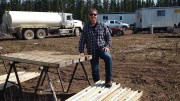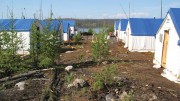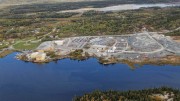Uranium companies are staying upbeat, given what they see are strong long-term fundamentals for uranium as the number of nuclear reactors around the world increase, despite the current situation of a weakening uranium price and low market activity.
Year-to-date, 33.1 million lb. uranium oxide (U3O8) have changed hands on the spot market, which is 15% less than last year. The number of deals has also dropped, TD Securities analysts Greg Barnes and Craig Hutchison write in an Oct. 21 note. The same is true for term demand.
 Cameco’s now closed Rabbit Lake uranium mine in northern Saskatchewan. Credit: Cameco.
Cameco’s now closed Rabbit Lake uranium mine in northern Saskatchewan. Credit: Cameco.
Given the continued soft demand, the uranium spot price has plunged 46% this year to close Oct. 31 at US$18.75 per lb. U3O8 — its lowest point in 12 years. Over the same time, the long-term price has fallen 18% to US$36 per pound.
The sluggish demand stems from the slow restart of Japan’s nuclear reactors, reactor shutdowns in other countries and the slowing global economy, the World Nuclear Association (WNA) says.
After the Fukushima nuclear disaster in 2011, Japan took its 42 nuclear reactors offline, which accounted for 10% of all the reactors in the world. Since then, Japan has restarted only three reactors.
Meanwhile, Germany closed nine of its 17 reactors since 2011. It plans to shutter its remaining reactors by 2022. In the last three years, the U.S. has closed five reactors. It aims to retire another three reactors by 2020, partly due to cheaper shale gas, the WNA states.
Despite this, the number of nuclear reactors under construction in other countries is rising, providing a bright spot for uranium in the long term.
At the end of 2015, there were 439 operable reactors around the world and another 66 reactors under construction, with a further 158 planned. Half of those reactors under construction are in East Asia, with China alone building 24.
“These are not easy days in the uranium business. Yet at Cameco, we remain optimistic. We see growth in reactor construction, and consequently, uranium consumption,” Tim Gitzel said on a recent conference call. Gitzel heads Cameco (TSX: CCO; NYSE: CCJ), Canada’s largest uranium producer.

Drill rigs at NexGen Energy’s Rook 1 uranium project in the southwest Athabasca basin in Saskatchewan. Credit: NexGen Energy.
Canada’s uranium-rich Athabasca basin
Since 2009, Canada has been the world’s second-largest uranium producer, behind Kazakhstan. Most of Canada’s production comes from the McArthur River and Cigar Lake mines in Saskatchewan’s uranium-rich Athabasca basin. These Cameco-operated mines are the largest and highest-grade uranium assets in the world.
While CEO Gitzel is optimistic that demand will return to the market, his company Cameco has sliced costs over the last five years to stay competitive in the low-priced environment.
Since 2011, Cameco has slashed its capital expenses by 56% to $245 million this year. Exploration spending has dropped from $85 million in 2011 to around $47 million this year.
Earlier this year, Cameco suspended its Rabbit Lake mine in the basin and curbed output from the United States. These were the company’s highest-cost operations. Cameco also scaled back output from the McArthur River-Key Lake operations, so it could focus on its low-cost assets, particularly its 50%-held Cigar Lake mine. Cigar Lake started commercial production last May. This year, the mine should produce 16 million lb. on a 100% basis.
More recently, a strong performance from Cameco’s uranium segment has led to third-quarter earnings of $142 million, or 36¢ per share. Last year the company reported a loss of $4 million, or 1¢ per share. Cash production costs in the quarter fell 27% year-over-year to $18.16 per pound.
“Cameco’s contract book continues to protect it against low uranium prices,” BMO analyst Edward Sterck says. Cameco had a realized uranium price of US$43 per lb. in the third quarter, which is 77% higher than the average spot price. However, it also ended two long-term contracts with its utility costumers, gaining $59 million.
Cameco is keeping its 2016 production guidance at 25.8 million lb. U3O8, which it lowered earlier from 30 million pounds. However, the company expects 2016 revenues that are 10% to 15% lower than 2015’s $2.8 billion, largely due to declining revenue from its Nukem segment.
Meanwhile, a trial over a tax dispute with the Canadian Revenue Agency is ongoing. A final decision could be out as early as 2018.
Cameco processes ore from Cigar Lake at Areva’s 70%-held McClean Lake mill, 70 km northeast. Denison Mines (TSX: DML; NYSE-MKT: DNN) and OURD own the rest of the mill.
Areva also holds 69% of the Midwest uranium development project in the Athabasca basin, while Cameco has a 70% interest in the Millennium development project.
Millennium sits between McArthur River and Key Lake, and has an indicated resource of 1.4 million tonnes grading 2.4% U3O8 for 75.9 million pounds. However, Cameco halted the project’s permitting process in May 2014, citing poor market conditions.
“We would have to see a significant improvement in the market to consider bringing any new deposits into production,” Gord Struthers, Cameco’s spokesperson, said in an email.

Areva, Denison Mines and OURD Co.’s McClean Lake uranium mill in northern Saskatchewan. Credit: Denison Mines.
Promising projects
NexGen Energy (TSX: NXE) is drilling the Rook 1 property, which contains the growing Arrow deposit. Rook 1 is in the basin’s southwest, near Fission Uranium’s (TSX: FCU) Patterson Lake South (PLS) property.
Despite the near-term uncertainty for uranium, NexGen has beefed up its exploration budget from $5.5 million in 2013 to $40 million this year. Over the same time, NexGen has bumped up its general and administrative costs by $1.1 million to $3.4 million, Travis McPherson, the company’s corporate development manager, said in an email.
In March, NexGen tabled Arrow’s maiden inferred resource estimate of 3.5 million tonnes grading 2.7% U3O8 for 202 million pounds. This included a high-grade core of 410,000 tonnes at 13.3% for 121 million pounds.
If the resource’s cut-off grade is increased from 0.3% to 10% U3O8, the deposit still contains over 100 million lb. at nearly 21% U3O8, McPherson notes, illustrating Arrow’s high-grade nature.
Recent drill results have shown that the Arrow deposit continues to grow, while infill results have indicated “strength of continuity in terms of grade and thickness at the deposit,” McPherson says. Moreover, metallurgical results have shown recovery rates of over 98%, as well as low deleterious elements.
NexGen’s mid-year program should wrap up shortly. With $75 million on hand, the company has enough to fund its 2017 drilling and resource update, as well as a prefeasibility study. The latter should be out in late 2017.
Fission continues to explore its PLS property on the basin’s southwest margin. It recently found high-grade mineralization outside of the Triple R deposit on PLS.
A preliminary economic assessment (PEA) in September 2015 envisioned that a combined open-pit and underground operation at Triple R could produce 101 million lb. over a 14-year mine life, where it would deliver 77.5 million lb. in the first six years. Average operating costs were US$14.02 per lb. over the mine life. A resource update should be out in early 2017. Fission exited September with more than $63 million in cash.
Denison is exploring the 60%-held Wheeler River and Waterbury Lake projects in the eastern side of the basin. Denison initiated a prefeasibility study on the Wheeler project in July. The company recently completed its summer drilling program at Wheeler, where it found mineralized extensions to the Gryphon deposit.

NexGen Energy’s Arrow uranium project in northern Saskatchewan’s Athabasca basin. Credit: NexGen Energy.
Given that the Gryphon and Phoenix deposits at Wheeler have more than 110 million contained lb. U3O8, the project “could become a source of supply in the eastern Athabasca over the longer term,” BMO’s Sterck says. However, Sterck adds that a higher uranium price could advance Wheeler to production. At the end of September, Denison had nearly $12 million in cash and equivalents.
UEX (TSX: UEX) is working to improve the economics of its 100% held Hidden Bay project, where it completed a PEA in 2011 using a US$60 uranium price. It aims to grow the Shea Creek deposits, where Areva has a 50.9% interest. UEX can also earn up to 70% of the Christie Lake uranium project from JCU (Canada) Exploration. Christie sits 9 km along strike from McArthur River. UEX ended the third quarter with $7 million in its treasury.
Near-term market challenges
TD analysts Barnes and Hutchison say the uranium market is oversupplied because of a number of factors. These include strong primary production from new uranium projects and expansions, such as Cigar Lake. Underfeeding by uranium enrichment facilities is also to blame, with the analysts explaining that low prices and improved technology result in less uranium consumption to produce the same amount of enriched uranium. Strategic inventories are also disposed at disused nuclear and uranium operations. The earlier-than-expected shutdown of several reactors, particularly in the U.S., adds to the problem.
As a result, the analysts “do not expect the uranium market to rebalance before 2020, and with utilities well-supplied, expect demand to remain highly discretionary.”
Barnes and Hutchison have revised their long-term uranium price forecast to reach US$55 per lb. in 2023, compared to 2020 earlier.






A global shift to electric cars could impact overnight electricity demands; has this been considered in estimating future electricity production and the need to keep more nuclear power plants operating?